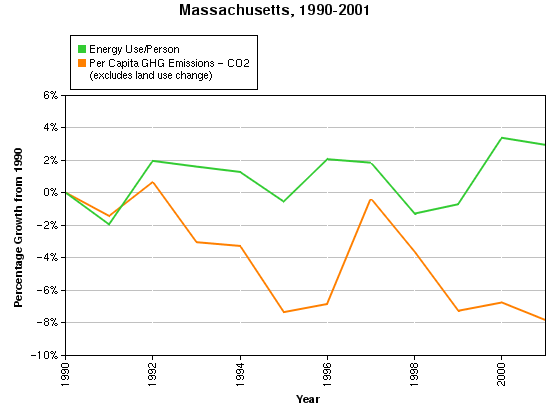Pursuant to the Global Warming Solutions Act, the Massachusetts Department of Environmental Protection has begun to produce Massachusetts Greenhouse Gas estimates which appear to be authoritative.
The materials below — all from other sources available in 2008 before passage of the GWSA — is retained on this site only for background and comparison.
The DOE profile for Massachusetts provides a useful overview of Massachusetts energy statistics.
Massachusetts Carbon Emissions by Sector.
Carbon Dioxide generation from fossil fuels breaks down as follows in Massachusetts (2003 data):
|
Heating/Direct |
Electric/Indirect |
Total |
|
| Residential | 17.0% | 12.0% | 29.0% |
| Commercial | 7.9% | 15.8% | 23.6% |
| Industrial | 7.9% | 6.1% | 14.1% |
| Transportation | 33.1% | 0.2% | 33.3% |
| Total | 65.9% | 34.1% | 100.0% |
This sectoral breakdown differs from the national average breakdown primarily in having a much higher share of emissions attributed to residential and commercial heating/direct emissions — these two entries constitute 24.9% of Massachusetts emissions, but only 10.5% emissions nationally. Industrial emissions are lower, at 14.1% total, compared to 29.9% nationally.
Total emissions in 2003 were 95.4 million tons of CO2 (including an estimated 7.5 million tons attributed to electricity imports at the same CO2/mwh rate as other Massachusetts power; 87.9 million tons, excluding the imports).
Sources for the sectoral breakdown above are the following: The EIA’s state by state energy consumption data (BTU’s of consumption by sector — tables S3 to S8). BTU to emissions conversion factors come from: EPA Greenhouse Gas Emissions Inventory, Table A-204; biomass was imputed 0 net emissions, and ethanol a coefficient of 20 — same as gasoline. Computations of emissions were made by applying the EPA emissions factors to the EIA BTU data, assuming mostly bituminous coal for 25.5 TgC/Qbtu coefficient. EPA computations supposedly using the same methodology as that presented here result in a slightly lower total (86.13 million tons, apparently exclusive of imports), but the same percentage breakdown; the computations from EPA do not do the allocation of direct and indirect by sector that is presented here, rather grouping all electric emissions together. The total emissions from electric generation as presented here also check fairly closely to emissions data in the EIA State Electricity Profiles, but EIA appears to round up the natural gas coefficient and use a materially higher coefficient for petroleum emissions — approximately 23.4 TgC/Qbtu, as compared to 21.5 for petroleum residual fuel in this analysis. For the computations summarized above, link to this spreadsheet 2003-mass-trillions-of-btu-by-sector-and-source.xls.
The carbon efficiency of Massachusetts’ power generation sector in 2003 appears from these numbers to be .586 tons of CO2 per megawatt hour in 2003 (55.5 million mwh of power sold — see EIA’s, Electricity Consumption data). This compares favorably to an efficiency average for years 1998-2000 of .639 t/mwh computed by the EIA and reflects a continuing migration to more use of natural gas which has a lower carbon to energy ratio than oil and coal. Gas consumption for power generation in Massachusetts increased almost three fold from 1990 to 2003. See EIA time series data. In a longer view, from 1960 to 2003, all-sector coal and petroluem consumption fluctuated against each other and declined overall, while natural gas increased almost six fold. See historical energy consumption from EIA.
Comparisons to other States
In 2001, Massachusetts ranked 43d in terms of tons of CO2 per person, with 12.7, as compared to a United States average of 20.1, a European Union average of 8.7, 2.7 in China, and a developing world average of 2.0. See World Resource Institute’sCAIT-US tool and its CAIT international tool which also allows regional analysis. This tool is accessible through: http://cait.wri.org/login-main.php?log=7&postlogin=cait-us (free registration required).
As noted above, Massachusetts has relatively high residential and commercial heating costs which reflect a cooler climate. Another issue, which is more salient in inter-state than in international comparisons, is economic integration — consumers in one state may drive high carbon emissions in another state. Thus, Massachusetts has relatively low industrial emissions and a relatively small agricultural sector, not even registering on the CAIT-US crop acres harvested tabulation.
Massachusetts does have relatively low vehicle miles traveled, ranking 44th at 8,290 vehicle miles travelled per person in 2001.
Trends
Massachusetts carbon emissions have been more or less stable recently. Population has been flat and, although energy consumption per capita has risen, the transition to natural gas noted above has materially improved the state’s carbon profile. See the graph below from CAIT.

